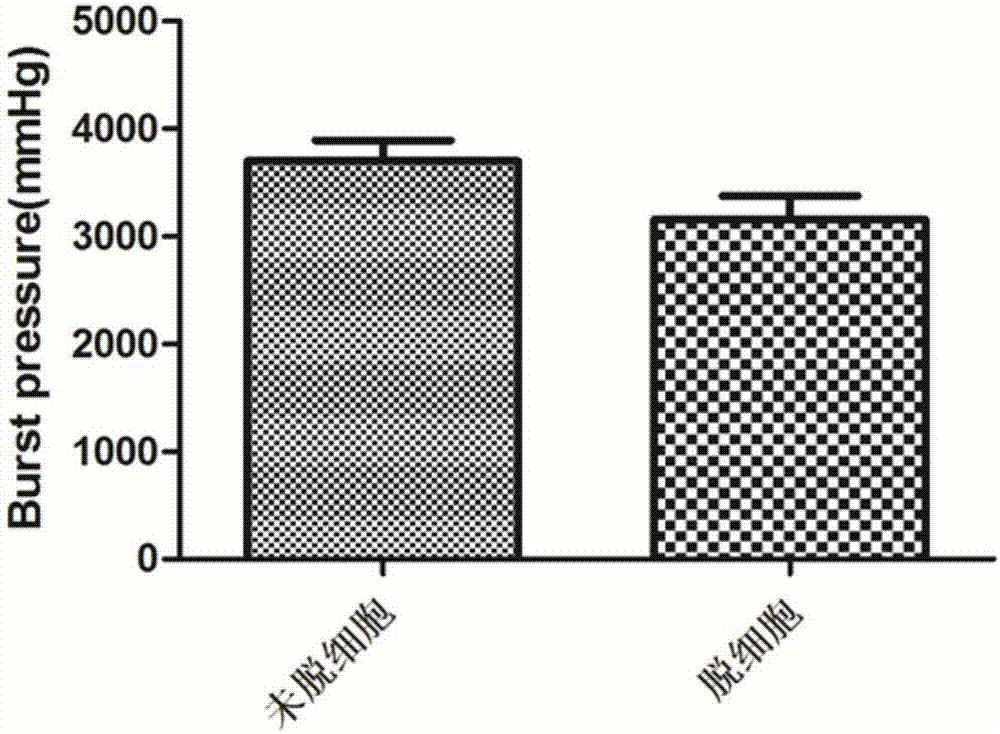Kit and method for permanently keeping artificial blood vessel smooth
An artificial blood vessel and kit technology, used in prosthesis, tissue regeneration, medical science and other directions, can solve the problems of weak mechanical properties, complex preparation process, intimal hyperplasia, etc., and achieve improved mechanical properties and patency rate, mild structure and Long-lasting effect of mechanical properties and anti-clogging properties
- Summary
- Abstract
- Description
- Claims
- Application Information
AI Technical Summary
Problems solved by technology
Method used
Image
Examples
Embodiment 1
[0034] 1) Preparation of artificial tubular tissue
[0035] Cut the Teflon tube (outer diameter 1 / 16 inch, about 1.59mm) that matches the inner diameter of the blood vessel to be replaced to an appropriate length, sterilize it with 75% alcohol for 30 minutes, place it in the human subcutaneous tissue, and take it out after 4 weeks. The tube and surrounding neonatal tissue were taken out, and the Teflon tube was extracted to obtain an artificial tubular tissue with a thickness of 324.1±57.4 microns (n=6, n is the number of test samples, n has the same meaning below).
[0036] 2) Decellularization treatment
[0037] Configure the decellularization reagent as shown in Table 1
[0038] Table 1 Components of decellularization reagents
[0039]
[0040] Add the precisely weighed reagent into a clean wide-mouthed glass bottle and shake it on a shaker for 2-3 hours to fully dissolve the reagent. At this time, the solution becomes clear. Prepare a decellularization reagent and sto...
Embodiment 2
[0051] 1) Preparation of artificial tubular tissue
[0052] Cut the Teflon tube (outer diameter 1 / 16 inch, about 1.59mm) whose diameter matches the inner diameter of the blood vessel to be replaced to an appropriate length, sterilize with 75% alcohol for 30 minutes, place it in the subcutaneous tissue of the pig, take it out after 2 weeks and put the subcutaneous Teflon tube The tube was taken out together with surrounding neonatal tissue, and the Teflon tube was extracted to obtain artificial tubular tissue with a thickness of 154.3±56.4 μm (n=6).
[0053] 2) Decellularization treatment
[0054] Configure the decellularization reagent as shown in Table 3
[0055] Table 3 Components of Decellularization Reagent
[0056]
[0057] Add the precisely weighed reagent into a clean wide-mouthed glass bottle and shake it on a shaker for 2-3 hours to fully dissolve the reagent. At this time, the solution becomes clear. Prepare a decellularization reagent and store it at 4°C for la...
Embodiment 3
[0068] 1) Preparation of artificial tubular tissue
[0069] Cut the Teflon tube (outer diameter 1.59mm) that matches the inner diameter of the blood vessel to be replaced to an appropriate length, sterilize it with 75% alcohol for 30 minutes, and place it under the human skin (it can also be implanted in other mammals such as mice, pigs, etc. Subcutaneous) tissue was taken out after 5 weeks. The subcutaneous Teflon tube was taken out together with the surrounding new tissue, and the Teflon tube was removed to obtain artificial tubular tissue with a thickness of 352.1±43.2 microns (n=6).
[0070] 2) Decellularization treatment
[0071] Configure the decellularization reagent as shown in Table 5
[0072] Table 5 Components of Decellularization Reagent
[0073]
[0074] Add the precisely weighed reagent into a clean wide-mouthed glass bottle and shake it on a shaker for 2-3 hours to fully dissolve the reagent. At this time, the solution becomes clear. Prepare a decellulariza...
PUM
| Property | Measurement | Unit |
|---|---|---|
| length | aaaaa | aaaaa |
| thickness | aaaaa | aaaaa |
| thickness | aaaaa | aaaaa |
Abstract
Description
Claims
Application Information
 Login to View More
Login to View More - R&D
- Intellectual Property
- Life Sciences
- Materials
- Tech Scout
- Unparalleled Data Quality
- Higher Quality Content
- 60% Fewer Hallucinations
Browse by: Latest US Patents, China's latest patents, Technical Efficacy Thesaurus, Application Domain, Technology Topic, Popular Technical Reports.
© 2025 PatSnap. All rights reserved.Legal|Privacy policy|Modern Slavery Act Transparency Statement|Sitemap|About US| Contact US: help@patsnap.com



